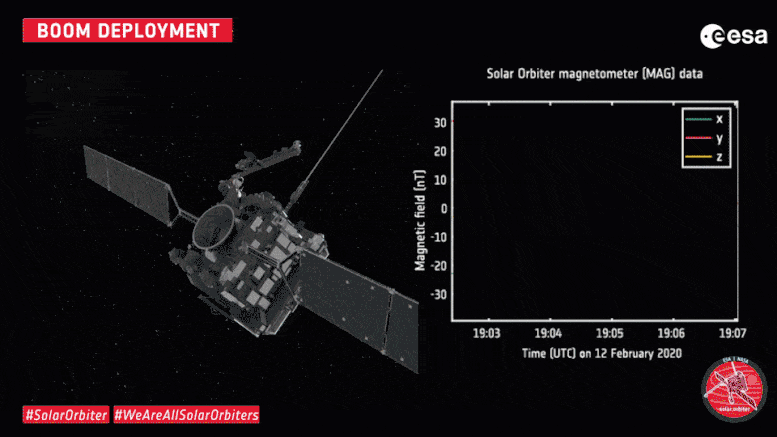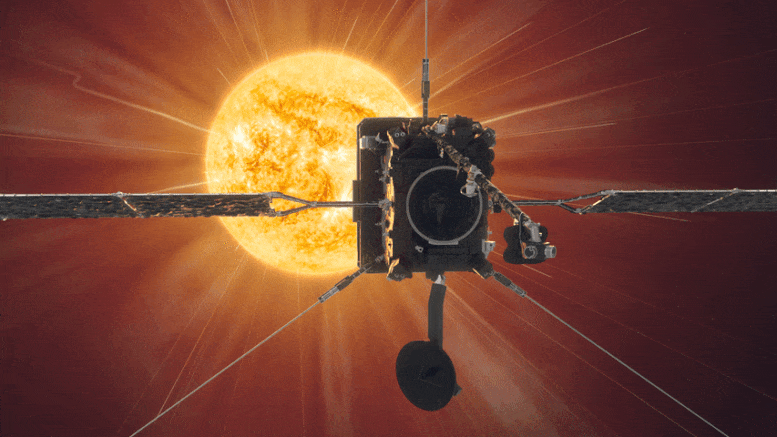ESA’s solar researcher Solar Orbiter reached its first perihelion, the point in its orbit closest to the star, on June 15, 2020, and approached 77 million kilometers from the star’s surface. Photo credit: ESA / Medialab

Solar Orbiters Suite of ten scientific instruments that will study the sun. There are two types: in-situ and remote sensing. The in-situ instruments measure the conditions around the spaceship itself. The remote sensing instruments measure what is happening at a great distance. Both sets of data can be used together to get a more complete picture of what is happening in the solar corona and solar wind. Photo credit: ESA-S.Poletti
Once a mission is in space, the teams work on putting the instruments into operation and collecting scientific data. As soon as the information flows in, interest in the first data release increases.
For many space missions, the first data release is usually after six months or a year in order to reward the teams that built the instruments with an exclusive first look at the data. However, long before launch, it was agreed that Solar Orbiter would be different.
“We want Solar Orbiter to be one of the most open missions. This means that it is open to the whole world, not just the teams that built the instruments, ”says Yannis Zouganelis, Deputy Project Scientist for Solar Orbiter at ESA.
Based on the successful approach of previous solar physics missions, it was decided that the time between receiving the data on Earth and publishing it to the world would be a maximum of 90 days. During this time, the instrument teams calibrate the data recorded by the Solar Orbiter from its constantly changing distance from the sun. In the best case, that would be quick processing; With the pandemic facing unprecedented challenges this year, meeting the deadline is a double achievement.
“To do that in COVID-19 Times have been very challenging, “says Yannis.” But we are ready to deliver the data according to the plan to the scientific community so that they can do science with it. ”
The work begins long before the start, and the various instrument teams are preparing to receive and process their data. The teams themselves are made up of dozens of people, often in many different countries.
Once the instruments are collecting data, the mission enters a calibration phase where each instrument team puts a lot of work into understanding how their instrument works in space, whether the data coming back is as expected, and which instruments and spacecraft effects need to be corrected. For example, the instrument readings depend on the temperature of the detector, but often the thermometers are necessarily spaced apart. Therefore, the data must be calibrated with the actual thermal behavior of the spacecraft in orbit.
Once the working tool is understood, the teams process the data and send it to ESA’s European Space Astronomy Center (ESAC) near Madrid. There, the data is archived in the ESAC Science Data Center and made available to the public.
“It’s a coordinated effort that involves dozens of people from many different teams, many different countries, and all parties have to work together like an orchestra to make sure everything is ready at the right time,” says Yannis.
This orchestra is led by ESA archivist Pedro Osuna in collaboration with the ESAC Science Data Center. The effort requires a dedicated commitment from all instrument teams to convert the raw data into calibrated products for scientific analysis.
“If the data is received on site, it is raw data, all ones and zeros,” says Javier Rodríguez-Pacheco, University of Alcalá, and Principal Investigator of EPD. “This is sent to us and we convert it into physical units that can be used for scientific purposes.”
For this first data release, Javier says that most of the data has been cleaned and calibrated by hand. However, once they fully understand the responses of the various EPD sensors, in the future they want to create a data pipeline that can largely automate the process. Although there will always be someone overseeing the process.
The data published by RPW comes from readings taken after June 15, as the period before that was the commissioning phase rather than the science phase. “We do all sorts of weird things with the instrument during commissioning,” says Jan Soucek, Institute of Atmospheric Physics at the Czech Academy of Sciences in Prague and senior co-investigator at RPW.
In this mode, readings are collected in a number of ways, making them ill-suited for science. “If you want to look at statistics, you need to make sure that you are measuring things in a consistent way. So if we play the instrument all the time, it’s not very consistent, ”says Jan.
But as with the other instruments, once its behavior is known, the data can be processed relatively easily and quickly.

Data collected with the magnetometer (MAG) instrument while the instrument boom of ESA’s Solar Orbiter spacecraft was deployed shows how the magnetic field decreases from the proximity of the spacecraft to the actual location of the instruments. Credit: ESA; Spaceship: ESA / ATG Medialab; Data: ESA / Solar Orbiter / MAG
In the case of MAG, the task was to learn about all of the tiny magnetic fields that the spaceship itself creates when its various circuits and devices are turned on and off. Tim Horbury, Imperial College and MAG Principal Investigator, says the fact that the data is in on time is evidence of the hard work of the Imperial College engineering team.
“You have worked incredibly hard over the past few months. It was an immense amount of work, ”he says. “We publish a lot of it that no one has really looked at in detail. So I’m sure there will be a number of other miracles to come – we just don’t know what they are just yet. There is an enormous amount for people to do and I really hope people will dive in. ”
The fourth in-situ instrument, SWA, is still working on data processing and calibration. “We had a number of teething troubles that work safely with the high voltages that are an integral part of all three of our sensors,” says Christopher Owen, Mullard Space Science Laboratory at University College London and principal researcher at SWA. “As a result, we haven’t been able to collect as much data or spend as much time understanding performance as we would have liked.”
However, Chris is optimistic. “The sensors themselves are fundamentally healthy, and from the data we have, we can see that they are capable of delivering great science and fulfilling the vital role they play in achieving the unique goals of missiology.” , he says.
In the meantime, there is more than enough data from the other tools for the scientific community to begin with. A special edition of the journal parallel to the data release Astronomy and astrophysics will be published containing mission and instrument descriptions.
“Now every scientist from every country can call up the data and do science with it. In fact, hundreds of scientists are already working together to make sense of this unique data, ”says Yannis.



